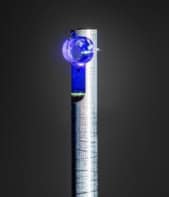Atomic collisions are often unavoidable in physics experiments, and they can be quite a nuisance. In particular, collisions between atoms that possess intrinsic or spin angular momentum can cause the atomic spins to be disoriented. This phenomenon is known as spin exchange and it has many undesirable consequences. Spin-exchange collisions can, for example, kick atoms out of laser-cooled Bose-Einstein condensates or cause changes in the “ticking rate” of atomic clocks.
Recently, however, spin-exchange collisions have been put to constructive use. Michael Romalis and Tom Kornack at Princeton University have used them to make significant progress in the technology of magnetometers devices that measure changes in magnetic field. Using a concept that was developed by the same researchers together with Joel Allred and Rob Lyman at Washington University in 2002, Romalis and Kornack have demonstrated a new, ultra-sensitive “co-magnetometer”. The device could be used to image the weak magnetic fields in living systems such as the brain, and to test the fundamental symmetries of nature (T W Kornack and M V Romalis 2002 Phys. Rev. Lett. 89 253 002).
In the March issue of Physics World, Richard Stoner from the Charles Stark Laboratory in Cambridge, Massachusetts and Ronald Walsworth from the Harvard-Smithsonian Center for Astrophysics discuss this magnetometer in more detail.



